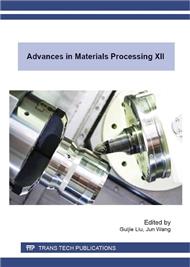p.3
p.9
p.14
p.20
p.26
p.32
p.38
p.44
p.50
A New Technology to Machine Bimetal Band Saw
Abstract:
As a kind of commonly used tools, junior hacksaw plays an important role in our daily life. A new kind of bimetal band saw taken low carbon medium alloy steel X32 as the backing material and the high-speed steel M42 as the saw tooth material is developed. In this paper, a new method to machine the bimetal band saw with wire electrical discharge machining (WEDM) is introduced. The processing route for common tooth profile is calculated. The fixture with specific angles is designed with CAD software (proe5.0) and machined with 3D printing technology. The experiments show that bimetal band saw machined with WEDM method has better surface quality compared with that machined through the traditional grinding process. Without any burrs, the new bimetal band saw is more resistant to wear and has a longer service life.
Info:
Periodical:
Pages:
9-13
Citation:
Online since:
July 2016
Authors:
Keywords:
Price:
Сopyright:
© 2016 Trans Tech Publications Ltd. All Rights Reserved
Share:
Citation:


